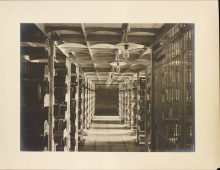You are here
Roger Nash Baldwin Papers
The Baldwin Papers consist mainly of typescript and manuscript documents, including personal correspondence, business correspondence, memoranda, published and typescript articles, manuscripts and notes for speeches, notes from travels, and printed material. There are also a considerable number of photographs and an album presented to Baldwin at the Thirtieth Anniversary of the ACLU, on February 22, 1950. The vast majority of the documents are in English, but there is also material in Spanish, German, and French, much but not all of which is translated.While there are materials relating to all eras of Baldwin's life, from his childhood in Wellesley, Massachusetts to his death in 1981, some eras are more fully documented than others. The collection contains no documents from his undergraduate years at Harvard. Much of the material relating to Baldwin's term as executive director of the ACLU (1920-1950) is located in the ACLU Archives. The papers in this collection relating directly to the ACLU date almost exclusively from 1950. The only exceptions are papers relating to the Scopes trial, which Baldwin managed, and the Sacco-Vanzetti case, which are relatively well-represented here. There are also surprisingly few documents relating to Baldwin's involvement with the International League for the Rights of Man.On the other hand, the materials relating to Baldwin's year in prison, his travels to the Soviet Union, Japan, Korea, and Germany, his interest in Puerto Rico, and his years in St. Louis are relatively rich. Baldwin's FBI file, although censored, sheds light on his involvement in radical politics. Also of interest are the memoranda Baldwin wrote throughout his later years about people he had known, experiences he had, and beliefs he had held. The photographs include many formal portraits ofBaldwin, his first baby picture to several taken while he was in his nineties, snapshots of dinners held in his honor, a few family pictures, pictures taken during his trips to Japan, Korea, and Germany, and various other photographs of his public life.An unusual feature of this collection is that Baldwin himself has included specifically for the researcher occasional explanations of who people were, what his connection with them was, or why he saved something. Baldwin also wrote a series of memoranda about his life, people he knew, and his opinions and attitudes. These autobiographical addenda to the collection infuse the collection with an unusually immediate sense of Baldwin's presence.
-
Public Policy Papers


